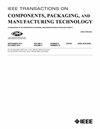Thermal Modeling and Analysis of Equivalent Thermal Properties for Advanced BEOL Stacks
IF 3
3区 工程技术
Q2 ENGINEERING, ELECTRICAL & ELECTRONIC
IEEE Transactions on Components, Packaging and Manufacturing Technology
Pub Date : 2025-04-28
DOI:10.1109/TCPMT.2025.3564833
引用次数: 0
Abstract
In this article, we introduce a modular thermal modeling methodology, BTE-FEM, that combines the Boltzmann transport equation (BTE) with finite element modeling (FEM) for simulations of advanced back-end-of-line (BEOL) stacks with high accuracy and efficiency. BTE-FEM is validated against direct BTE-based simulations using simplified BEOL stack test cases across various technology nodes and via connectivity configurations. It is demonstrated that conventional FEM, using bulk material properties, increasingly underestimates the BEOL thermal resistance as the technology node scales. In contrast, the BTE-FEM developed in this study demonstrates good agreement with direct BTE simulations for all test cases, but at much shorter runtimes. The impact of material properties, metal densities, and boundary conditions on the derived BEOL thermal properties are benchmarked and the developed models are experimentally validated at two distinct technology nodes. Finally, the developed methodology is applied to a 12-layer, 18 nm metal pitch BEOL stack from an A10 high density core design, demonstrating its ability to simulate complex and realistic BEOL routings with the precision of direct BTE simulations while substantially reduced simulation time. This approach enables extensive design of experiments (DOEs) for fast turnaround design iterations.先进BEOL堆的热模拟与等效热性能分析
在本文中,我们介绍了一种模块化热建模方法,BTE-FEM,该方法将玻尔兹曼输运方程(BTE)与有限元建模(FEM)相结合,用于高精度和高效率地模拟先进的后端线(BEOL)堆栈。使用简化的BEOL堆栈测试用例跨各种技术节点和通过连接配置,通过直接基于bte的模拟验证了BTE-FEM。结果表明,随着技术节点的扩大,传统的有限元方法在考虑材料本体特性的同时,越来越低估了BEOL热阻。相比之下,本研究中开发的BTE- fem与所有测试用例的直接BTE模拟表现出良好的一致性,但运行时间要短得多。对材料性能、金属密度和边界条件对所得BEOL热性能的影响进行了基准测试,并在两个不同的技术节点上对所开发的模型进行了实验验证。最后,将开发的方法应用于A10高密度核心设计的12层,18nm金属间距BEOL堆栈,证明其能够以直接BTE模拟的精度模拟复杂和真实的BEOL路由,同时大大缩短了模拟时间。这种方法为快速周转设计迭代提供了广泛的实验设计(do)。
本文章由计算机程序翻译,如有差异,请以英文原文为准。
求助全文
约1分钟内获得全文
求助全文
来源期刊

IEEE Transactions on Components, Packaging and Manufacturing Technology
ENGINEERING, MANUFACTURING-ENGINEERING, ELECTRICAL & ELECTRONIC
CiteScore
4.70
自引率
13.60%
发文量
203
审稿时长
3 months
期刊介绍:
IEEE Transactions on Components, Packaging, and Manufacturing Technology publishes research and application articles on modeling, design, building blocks, technical infrastructure, and analysis underpinning electronic, photonic and MEMS packaging, in addition to new developments in passive components, electrical contacts and connectors, thermal management, and device reliability; as well as the manufacture of electronics parts and assemblies, with broad coverage of design, factory modeling, assembly methods, quality, product robustness, and design-for-environment.
 求助内容:
求助内容: 应助结果提醒方式:
应助结果提醒方式:


